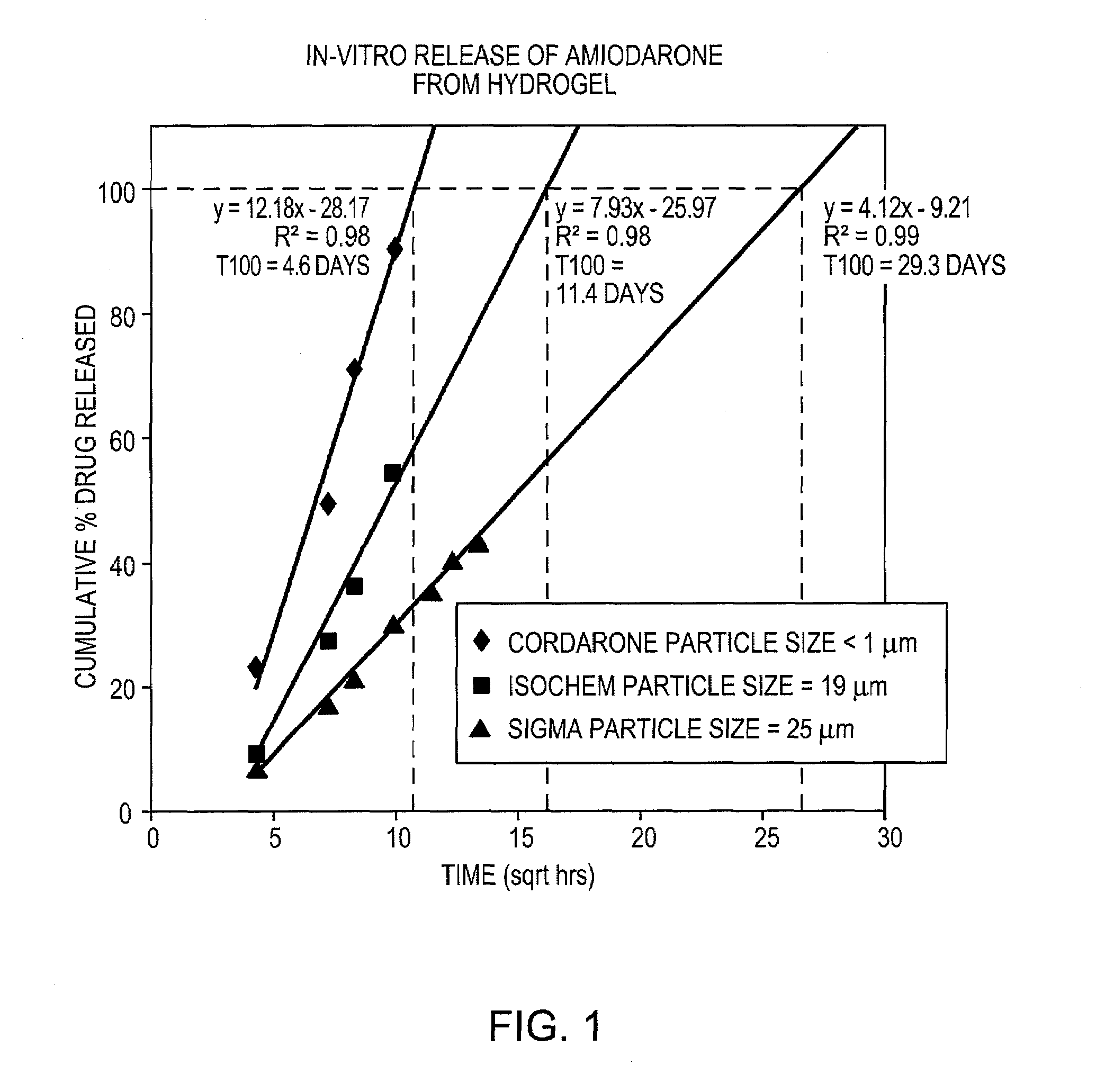Controlled release of anti-arrhythmic agents
a technology of anti-arrhythmic agents and controlled release, which is applied in the direction of aerosol delivery, drug compositions, prostheses, etc., can solve the problems of systemic administration of anti-arrhythmic agents that are not always desirable or practical, disturb the regulation of heartbeat, and complicate the recovery process, so as to achieve effective delivery of anti-arrhythmic drugs, and reduce the risk of heart attack
- Summary
- Abstract
- Description
- Claims
- Application Information
AI Technical Summary
Benefits of technology
Problems solved by technology
Method used
Image
Examples
example 1
Preparation of Amiodarone-loaded FOCALSEAL-L™ Hydrogel Patches Directly onto Tissue for Release of CORDARONE™
[0089]CORDARONE™ (Wyeth Laboratories Inc., Philadelphia, Pa.) (0.5 g) was added to FOCALSEAL-L™ macromer solution (Genzyme Corporation, Cambridge, Mass.) (4.5 mL) and the combination was mixed with a spatula until homogeneous. Over time, the material showed phase separation, which resulted from the precipitation of amiodarone from the macromer solution, and the material formed a submicron amiodarone suspension.
[0090]The resulting amiodarone suspension was applied to the myocardium of a live pig by brushing the FOCALSEAL-L™ primer solution onto the myocardium, mixing a small volume of the FOCALSEAL-L™ macromer component containing amiodarone with the primer, and overlaying the mixture with a larger volume of macromer component containing amiodarone. The material was then illuminated with 40 seconds of visible light to polymerize the macromer and form a hydrogel patch onto the ...
example 2
Amiodarone in a Solid Particulate Form in FOCALSEAL-L™
[0093]Amiodarone (Isochem, SNPE North America, Princeton, N.J.) (11 g) was added to a solution of distilled water containing 0.3125% PLURONIC™ F127 as surfactant (600 g). The particles were mixed to form a coarse suspension using a Caframo overhead mixer at 500 rpm for 5 minutes. Once the particles were completely wetted with the aqueous surfactant solution, the mixture was transferred to a microfluidizer (Microfluidics International Corp., Newton, Mass.) and homogenized at 20,000 psi for 15 minutes.
[0094]The fine suspension was transferred to a 2 L flask and assayed for drug content by HPLC. Based on the assay results, the drug concentration was adjusted to 1.43% by adding a solution of 0.25% PLURONIC™ F127 in distilled water. The solution was mixed well and part of the solution (700 g) was transferred to a 2 L beaker. The FOCALSEAL-L™ macromer (200 g) was added to the beaker and mixed until dissolved. A buffer containing 10× th...
example 3
Release Rate of Amiodarone from Hydrogels
[0097]Three different particle sizes of amiodarone were tested to determine the effect of particle size on release rate from hydrogels. Amiodarone was obtained from three different suppliers. Amiodarone purchased from a first supplier (Sigma) was determined to have a mean particle size of 25 microns by particle size analysis using a Malvern Mastersizer 2000. Amiodarone from a second supplier (Isochem) had a particle size of 19 microns. A third particle size was obtained by mixing CORDARONE™ brand amiodarone with a hydrogel forming solution, as described in Example 1. The CORDARONE™ material is an injectable solution of amiodarone in water containing TWEEN™ surfactant and benzyl alcohol. Upon mixing with the gel-forming solution, the amiodarone precipitated, forming a hazy suspension of non-settling particles. Microscopic examination indicated that these particles were submicron in size. Amiodarone from the other two suppliers was prepared in ...
PUM
| Property | Measurement | Unit |
|---|---|---|
| particle sizes | aaaaa | aaaaa |
| particle sizes | aaaaa | aaaaa |
| particle sizes | aaaaa | aaaaa |
Abstract
Description
Claims
Application Information
 Login to View More
Login to View More - R&D
- Intellectual Property
- Life Sciences
- Materials
- Tech Scout
- Unparalleled Data Quality
- Higher Quality Content
- 60% Fewer Hallucinations
Browse by: Latest US Patents, China's latest patents, Technical Efficacy Thesaurus, Application Domain, Technology Topic, Popular Technical Reports.
© 2025 PatSnap. All rights reserved.Legal|Privacy policy|Modern Slavery Act Transparency Statement|Sitemap|About US| Contact US: help@patsnap.com



